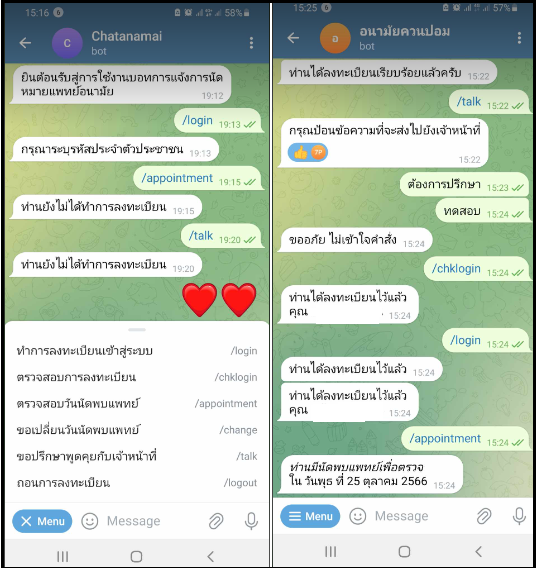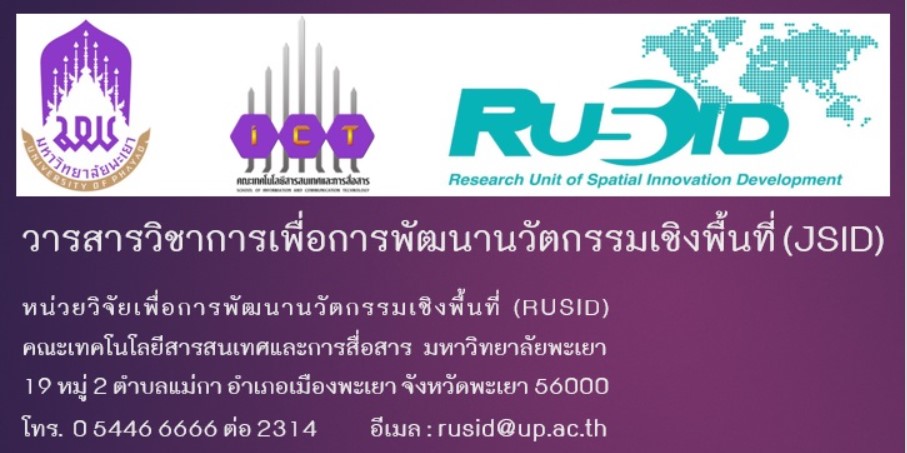ระบบนัดหมายและสื่อสารสำหรับสถานพยาบาลด้วยแชทบอท
คำสำคัญ:
แอปพลิเคชัน, นัดหมาย, การสื่อสาร, แชทบอท, สถานพยาบาลบทคัดย่อ
ในปัจจุบันการสื่อสารข้อความด้วยระบบแชทบนอุปกรณ์สมาร์ทดีไวท์ เป็นการสื่อสารที่มีความสะดวกและปลอดภัย ซึ่งการให้บริการข้อมูลโดยผ่านระบบแชทของสถานพยาบาลให้แก่ผู้ใช้บริการ จะสามารถอำนวยความสะดวก ประหยัด และปลอดภัยได้ โดยเฉพาะอย่างยิ่งในสภาวะการณ์โรคระบาดหรือมีการเดินทางที่ลำบากไม่ปลอดภัย ดังนั้นเพื่อให้เกิดการใช้ประโยชน์ในการใช้เทคโนโลยีมือถือ ซึ่งจะเพิ่มความสะดวก ประหยัด และปลอดภัยให้แก่ผู้ใช้บริการ
จึงเกิดแนวคิดในการพัฒนาระบบนัดหมายและการสื่อสารสำหรับสถานพยาบาลด้วยแชทบอท ซึ่งงานวิจัยนี้มีวัตถุประสงค์ ดังนี้ 1) เพื่อพัฒนาระบบแชทบอทเพื่อการนัดหมายและการสื่อสารสำหรับสถานพยาบาล 2) เพื่อประเมินประสิทธิภาพการทำงานของระบบ และ ประเมินความพึงพอใจต่อการใช้งานของผู้ใช้ เทคโนโลยีที่ใช้ในการพัฒนาระบบแชทบอทประกอบด้วย 1) ระบบฐานข้อมูล ซึ่งเก็บรวบรวมข้อมูล (Data Collection) โดยการดึงข้อมูลบางส่วนจากฐานข้อมูลของโรงพยาบาลส่งเสริมสุขภาพตำบล จากโปรแกรม JHCIS ( Java Health Center Information System) 2) การออกแบบชุดคำสั่งในแชทบอท จะใช้โปรแกรมส่งข้อความเทเลแกรม (Telegram) เพื่อออกแบบชุดคำสั่งในแชทบอท และ การสร้างช่องทางในการรับส่งข้อความ กระจายข่าวสาร โดยข้อความจะถูกเข้ารหัสเอาไว้เพื่อป้องกันบุคคลภายนอกเข้ามาเจาะระบบ 3) ภาษาโก (Golang) สำหรับการโหลดข้อมูลตั้งต้น และปรับปรุงข้อมูลการนัดหมายต่าง ๆ ในการประเมินประสิทธิภาพการทำงานของระบบโดยผู้เชียวชาญจำนวน 5 คน และ มีกลุ่มผู้ใช้งาน จำนวน 100 คน สามารถสรุปผลการประเมินเป็น 2 ด้าน ประกอบด้วย ด้านประสิทธิภาพของระบบ และการใช้งานของระบบ โดยใช้ค่าสถิติ ค่าร้อยละ ค่าเฉลี่ย และค่าส่วนเบี่ยงเบนมาตฐาน (S.D) โดยมีการนำผลที่ได้ มาเปรียบเทียบกับเกณฑ์มาตรฐานของการประเมิน ผลการประเมินคุณภาพของการใช้งานระบบ และ ประสิทธิภาพของระบบ เฉลี่ยโดยรวมอยู่ในระดับดีมาก ค่าเฉลี่ย = 4.54 และ ค่า S.D = 0.54 เมื่อพิจารณาแต่ละประเด็น พบว่า ประเด็นด้านการใช้งานของระบบมีค่าเฉลี่ยอยู่ที่ 4.53 ,S.D = 0.65 และ ประเด็นประสิทธิภาพของระบบ มีค่าเฉลี่ยอยู่ที่ 4.55 ,S.D = 0.56
เอกสารอ้างอิง
กาญจนา เพิ่มพูล, มานิสา ระชะตะ และหทัยรัตน์ เกตุมณี ชัยรัตน์. (2559). การประเมินความ พึงพอใจของผู้ใช้ระบบแจ้งเตือน กำหนดการสำหรับ วิทยาลัยเทคโนโลยี อุตสาหกรรม. Phetchabun Rajabhat Journal (ราชภัฏเพชรบูรณ์สาร), 17(1), 33-42.
จักรพงษ์ รัตนโยธิน และวชิรศักดิ์ วานิชชา. (2560). การออกแบบ และ พัฒนาแอนดรอยด์ แอปพลิเคชัน การแจ้งเตือนรับประทานยาเพื่อเพิ่มคุณภาพการรักษาผู้ป่วยโรคหลอดเลือด สมอง. วารสาร วิชาการ ปทุมวัน Pathumwan Academic Journal, 7(20), 29-44.
ชุมพล โมฆรัตน์, วรางคณา อุ่นชัย และ สุกัญญา มารแพ้. (2559). แอปพลิเคชั่นแชทบอท เพื่อการวินิจฉัยโรคเบาหวาน ด้วยออนโทโลยี. The 20th Internation Computer Science and Engineering Conference 2016, iCSEC 2016 (519-524), 14-17 December 2016.
วิริยะ รอดโพธิ์ทอง. (2561). การพัฒนาระบบการจัดการนัดหมายของงาน ATF 2018. การประชุมวิชาการระดับชาติและนานาชาติ มหาวิทยาลัยศรีปทุม วิทยาเขตชลบุรี ปี 2561 National and International conference (SPUC).
วิไลลักษณ์ ลูกอินทร์ และอดุลย์ โต๊ะบก. (2558). ระบบการจัดการคลินิกทันตกรรม. การประชุมวิชาการ ระดับ ปริญญาตรีด้านคอมพิวเตอร์ภูมิภาคอาเซียน 2015” (The ASEAN Undergraduate Conference in Computing: AUC2 2015). ฉะเชิงเทรา: มหาวิทยาลัยราชภัฏ ราชนครินทร์.
สุวิมล ผาบแก้ว และ ธนากร อุยพานิชย์. (2561). แอปพลิเคชันสำหรับนัดหมายผู้ป่วยทันตกรรมผ่านระบบปฏิบัติการแอนดรอยด์. Journal of Humanities and Social Sciences, Suan Sunandha Rajabhat University, 1(2), 77-89.
Abdul-Kader, S. A., & Woods, J. (2017), September). Question answer system for online feedable new born Chatbot. In 2017 Intelligent Systems Conference (IntelliSys), 863-869.
Budsabok, S., Pechpong, N., & Singtokaeo, C. (2563). การพัฒนาแอปพลิเคชัน Chatbot สำหรับงานบริการ นักศึกษา กรณีศึกษากองพัฒนานักศึกษา มหาวิทยาลัยเทคโนโลยีราชมงคล สุวรรณภูมิ. Journal of Applied Research on Science and Technology (JARST), 19(2), 85-94.
Chabbi, M., & Ramanathan, M. K. (2022, June). A study of real-world data races in Golang. Proceedings of the 43rd ACM SIGPLAN International Conference on Programming Language Design and Implementation (474-489).
Likert, R. (1932). A Technique for the Measurement of Attitudes. Archives of Psychology, 140, 1–55.
Maheshwari, S., & Jain, D. C. (2012). A comparative analysis of different types of models in software development life cycle. International Journal of Advanced Research in Computer Science and Software Engineering, 2(5), 285-290.
Phetkrachang K., Kittiphattanabawon N., (2019, November). A Thai Ontology- Based Framework for Diabetes Question and Answers. In 10th International Science, Social Science, Engineering and Energy Conference I-SEEC Thailand, 1-9.
Tan, O. (2017). How AI can improve the customer experience. Forbes Technology Council.





